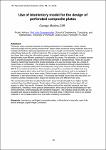Use of biomimicry model for the design of perforated composite plates
| dc.contributor.author | Modica-Cliff, G. | |
| dc.date.accessioned | 2023-07-27T13:01:28Z | |
| dc.date.available | 2023-07-27T13:01:28Z | |
| dc.date.issued | 2023 | |
| dc.identifier.citation |
Modica-Cliff, G. (2023) 'Use of biomimicry model for the design of perforated composite platesl', The Plymouth Student Scientist, 16(1), pp. 49-85. | en_US |
| dc.identifier.uri | https://pearl.plymouth.ac.uk/handle/10026.1/21078 | |
| dc.description.abstract |
There are many practical reasons for making perforations in composites, which include reducing weight and for joining components. Nature often produces strong materials that have multiple perforations allowing organisms to survive in tough environments, biomimicry seeks to utilise these features for artificial solutions. The project proposes to investigate natural structures then using the information gained, to suggest methods by which we could design/make more efficient openings in composite structures. For example, to increase window size in aircraft structures without compromising strength or aerodynamics. Holes are usually made by machining however this project proposes a to use tree knots holes as a model to mould holes in composites. The project will validate its predictions through experimentation. Three types of sample plates were manufactured using resin infusion under flexible tooling (RIFT) and unidirectional fibres. Test samples using both a moulded and drilled hole are compared against each other and that of a control sample without a hole to investigate if tensile improvements have been made. Digital image correlation (DIC) analysis shows a difference in the failure mode of each. The project was limited due to time and resources, so could be usefully repeated with a larger test sample size and different hole sizes. The results show that the moulded holes had a lower tensile strength but a higher tensile modulus than the drilled sample. The location of tow and stitching in the top layer did not appear to affect the results. However, the failure mode of the moulded samples was less catastrophic, showing a more gradual deterioration, which would prove advantageous in real-world scenarios, where products are monitored regularly. This process could be useful as it is reusable and saves on additional machining time and costs. Furthermore, there is no wasted material or risk of delamination and dust when installing components. | en_US |
| dc.language.iso | en | en_US |
| dc.publisher | University of Plymouth | en_US |
| dc.rights | Attribution 3.0 United States | * |
| dc.rights.uri | http://creativecommons.org/licenses/by/3.0/us/ | * |
| dc.subject | biomimicry | en_US |
| dc.subject | perforated composite plates | en_US |
| dc.subject | unidirectional composite | en_US |
| dc.subject | open hole tensile strength | en_US |
| dc.subject | digital image Correlation | en_US |
| dc.title | Use of biomimicry model for the design of perforated composite plates | en_US |
| dc.type | Article | en_US |
| plymouth.issue | 1 | |
| plymouth.volume | 16 | |
| plymouth.journal | The Plymouth Student Scientist |




